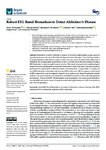Robust EEG Based Biomarkers to Detect Alzheimer’s Disease
| dc.contributor.author | Al-Nuaimi, AH | |
| dc.contributor.author | Blūma, M | |
| dc.contributor.author | Al-Juboori, SS | |
| dc.contributor.author | Eke, CS | |
| dc.contributor.author | Jammeh, E | |
| dc.contributor.author | Sun, L | |
| dc.contributor.author | Ifeachor, E | |
| dc.date.accessioned | 2021-10-15T12:40:05Z | |
| dc.date.issued | 2021-07-31 | |
| dc.identifier.issn | 2076-3425 | |
| dc.identifier.issn | 2076-3425 | |
| dc.identifier.other | ARTN 1026 | |
| dc.identifier.uri | http://hdl.handle.net/10026.1/18074 | |
| dc.description.abstract |
<jats:p>Biomarkers to detect Alzheimer’s disease (AD) would enable patients to gain access to appropriate services and may facilitate the development of new therapies. Given the large numbers of people affected by AD, there is a need for a low-cost, easy to use method to detect AD patients. Potentially, the electroencephalogram (EEG) can play a valuable role in this, but at present no single EEG biomarker is robust enough for use in practice. This study aims to provide a methodological framework for the development of robust EEG biomarkers to detect AD with a clinically acceptable performance by exploiting the combined strengths of key biomarkers. A large number of existing and novel EEG biomarkers associated with slowing of EEG, reduction in EEG complexity and decrease in EEG connectivity were investigated. Support vector machine and linear discriminate analysis methods were used to find the best combination of the EEG biomarkers to detect AD with significant performance. A total of 325,567 EEG biomarkers were investigated, and a panel of six biomarkers was identified and used to create a diagnostic model with high performance (≥85% for sensitivity and 100% for specificity).</jats:p> | |
| dc.format.extent | 1026-1026 | |
| dc.format.medium | Electronic | |
| dc.language | en | |
| dc.language.iso | en | |
| dc.publisher | MDPI | |
| dc.subject | robust EEG based biomarkers | |
| dc.subject | detection of Alzheimer's disease | |
| dc.subject | slowing of the EEG | |
| dc.subject | reduction in EEG connectivity | |
| dc.subject | reduction in EEG complexity | |
| dc.title | Robust EEG Based Biomarkers to Detect Alzheimer’s Disease | |
| dc.type | journal-article | |
| dc.type | Article | |
| plymouth.author-url | https://www.ncbi.nlm.nih.gov/pubmed/34439645 | |
| plymouth.issue | 8 | |
| plymouth.volume | 11 | |
| plymouth.publication-status | Published online | |
| plymouth.journal | Brain Sciences | |
| dc.identifier.doi | 10.3390/brainsci11081026 | |
| plymouth.organisational-group | /Plymouth | |
| plymouth.organisational-group | /Plymouth/Faculty of Science and Engineering | |
| plymouth.organisational-group | /Plymouth/Faculty of Science and Engineering/School of Engineering, Computing and Mathematics | |
| plymouth.organisational-group | /Plymouth/REF 2021 Researchers by UoA | |
| plymouth.organisational-group | /Plymouth/REF 2021 Researchers by UoA/UoA11 Computer Science and Informatics | |
| plymouth.organisational-group | /Plymouth/REF 2021 Researchers by UoA/UoA12 Engineering | |
| plymouth.organisational-group | /Plymouth/Users by role | |
| plymouth.organisational-group | /Plymouth/Users by role/Academics | |
| plymouth.organisational-group | /Plymouth/Users by role/Researchers in ResearchFish submission | |
| dc.publisher.place | Switzerland | |
| dcterms.dateAccepted | 2021-07-27 | |
| dc.rights.embargodate | 2021-10-16 | |
| dc.identifier.eissn | 2076-3425 | |
| dc.rights.embargoperiod | Not known | |
| rioxxterms.versionofrecord | 10.3390/brainsci11081026 | |
| rioxxterms.licenseref.uri | http://www.rioxx.net/licenses/all-rights-reserved | |
| rioxxterms.licenseref.startdate | 2021-07-31 | |
| rioxxterms.type | Journal Article/Review |


